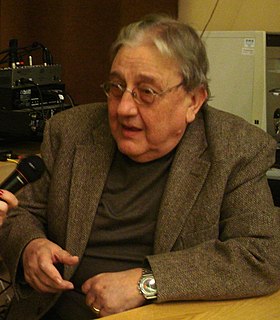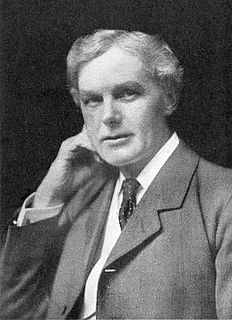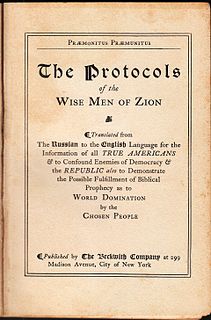
Sergei Aleksandrovich Nilus was a Russian religious writer and self-described mystic.

The Britons was an English anti-Semitic and anti-immigration organisation founded in July 1919 by Henry Hamilton Beamish. The organisation published pamphlets and propaganda under imprint names: Judaic Publishing Co. and later (The) Britons Publishing Society. These entities mainly engaged in disseminating anti-Semitic literature and rhetoric in the United Kingdom and called for greater nationalism, being considered academically among the forefront of British Fascists. Imprints under the first label exist for 1920, 1921, and 1922.

Cesare G. De Michelis is a scholar and professor of Russian literature at the University of Rome Tor Vergata, Italy.

John Henry Clarke was an English classical homeopath. He was also, arguably, the most important anti-Semite in Great Britain. He led The Britons, an anti-Semitic organisation. Educated at the University of Edinburgh, he received his medical degree in 1877.
Georgy Butmi de Katzman — Russian journalist, writer and economist, member of the Union of the Russian People.
Michael Hagemeister is a German historian and Slavist, an authority on The Protocols of the Elders of Zion and on Sergei Nilus.
Boris Leo Brasol, lawyer and literary critic, was a White Russian immigrant to the United States.
Britons Publishing Society, founded in 1923, was an offshoot of The Britons. According to scholar Gisela C. Lebzelter, The Britons split because:
... internal disagreements proved paralysing. Seven members were excluded in November 1923, and three executives members, J. H. Clarke, the famous British homeopath, R. T. Cooper and W. A. Peters, seceded to establish 'The Britons Publishing Society'.
George Shanks (1896–1957) was an expatriate Briton born in Moscow and was the first translator of Protocols of Zion from Russian into English. He was also a founding member of Radio Normandy. George Shanks was the son of Henry Shanks, a well-known British merchant who resided in Moscow. Henry Shanks managed the family firm of Shanks & Bolin, Magasin Anglais established by his father James Steuart Shanks in 1852. As a result of the Russian Revolution of 1917, the family lost their business and home and were forced to return to London. It is believed that the translation was completed during this period in London. His identity was not discovered until 1978; initially, it was believed that Victor E. Marsden was the translator, as his name came to be associated with the British English language translation of the Protocols in pamphlet or booklet form soon after he died in 1920.
Robert Singerman is a professor, a recognized Judaica bibliographer. He is often cited by Judaica rare book dealers. He holds the position of University Librarian, George A. Smathers Libraries, University of Florida, where he was the bibliographer for Jewish Studies, Anthropology, and Linguistics.

Harris Ayres Houghton was a physician and member of the United States military intelligence community during and shortly after World War I. He is notable for having arranged the anonymous translation and publication, from the Russian language into the English language, of the Protocols of the Elders of Zion in the United States in 1920. The lead title he was responsible for producing was "Praemonitus Praemunitus."
Natalie de Bogory (1887–1939) is primarily known for her work in translating from the Russian language into the English language, and subsequently distributing and participating in having published the first or second American edition in the United States of the document known as the Protocols of the Elders of Zion. There were two different editions printed in the United States in 1920. The earlier, entitled The Protocols and World Revolution, associated with Boris Brasol and published by Small, Maynard and Company. The later, entitled Praemonitus Praemunitus associated with Harris A. Houghton and published by the Beckwith Company.
Small, Maynard & Company, is a defunct publishing house located in Boston. In its day it was a highly reputable house in literature, and several US authors were published by it, including Walt Whitman.

The Beckwith Company was a publishing entity in 1920, based in New York City. It is remembered for publishing a second edition of the forged Protocols of the Elders of Zion, more specifically a second translation from the Russian language into the English language.
A Protocol of 1919 is a fabricated text appearing in the appendices of The Protocols of the Elders of Zion, purportedly found on 9 December 1919 among the documents of a Jewish Red battalion commander killed in the Estonian War of Independence. The document's supposed authors, the "Israelite International League", gloat over their success at reducing the Russian people to "helpless slaves", and urge their fellow Jews to "excite hatred" and "buy up Government loans and gold", in order to grow in "political and economic power and influence". The text has been cited, as with other antisemitic canards, as evidence for the antisemitic belief that the Jews are conspiring to take over the world.
The Singerman list is a numeric cataloging system for antisemitica items, as defined by the 1982 bibliographic listing, Antisemitic Propaganda: an annotated bibliography and research guide by Robert Singerman. The list consists of a chronological listing, by year at least, of books, pamphlets, and other sorts of texts, with full bibliographic information. In addition each item is assigned a unique 4-digit number with a short, paragraph-length, annotation. For example, "Singerman 0121" identifies uniquely a particular imprint of The Jewish Bolshevism.
Polish Logic is an anthology of papers by several authors—Kazimierz Ajdukiewicz, Leon Chwistek, Stanislaw Jaskowski, Zbigniew Jordan, Tadeusz Kotarbinski, Stanisław Leśniewski, Jan Łukasiewicz, Jerzy Słupecki, and Mordchaj Wajsberg—published in 1967 and covering the period 1920–1939. The work focuses on the contributions of Polish logicians, more particularly, mathematical logicians, to modern logic.

The Protocols of the Elders of Zion or The Protocols of the Meetings of the Learned Elders of Zion is a fabricated antisemitic text purporting to describe a Jewish plan for global domination. The hoax was plagiarized from several earlier sources, some not antisemitic in nature. It was first published in Russia in 1903, translated into multiple languages, and disseminated internationally in the early part of the 20th century. It played a key part in popularizing belief in an international Jewish conspiracy.
The Protocols of the Elders of Zion is a fabricated antisemitic text purporting to describe a Jewish plan to achieve global domination. The text was fabricated in the Russian Empire, and was first published in 1903. While there is continued popularity of The Protocols in nations from South America to Asia, since the defeat of Nazi Germany, Fascist Italy, and Imperial Japan in World War II, governments or political leaders in most parts of the world have generally avoided claims that The Protocols represent factual evidence of a real Jewish conspiracy. The exception to this is the Middle East, where a large number of Arab and Muslim regimes and leaders have endorsed them as authentic. Past endorsements of The Protocols from Presidents Gamal Abdel Nasser and Anwar Sadat of Egypt, Iraqi President Arif, King Faisal of Saudi Arabia, and Colonel Muammar al-Gaddafi of Libya, among other political and intellectual leaders of the Arab world, are echoed by 21st century endorsements from the Grand Mufti of Jerusalem, Sheikh Ekrima Sa'id Sabri, and Hamas, to the education ministry of Saudi Arabia.
Znamya was a newspaper established by ultra-nationalist Black Hundreds journalist Pavel Krushevan in Petersburg. It is known for publishing of the "Protocols of the Elders of Zion" in August–September 1903.




















